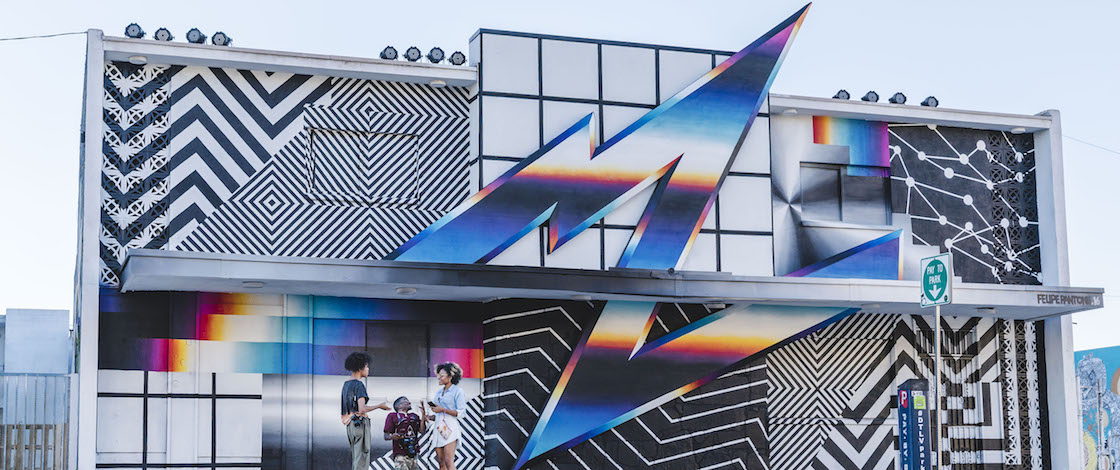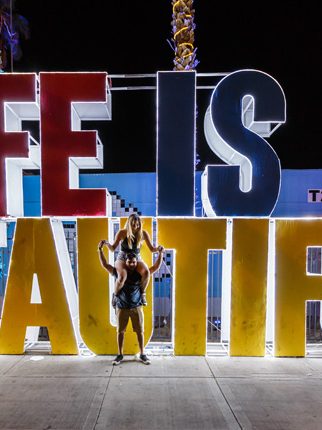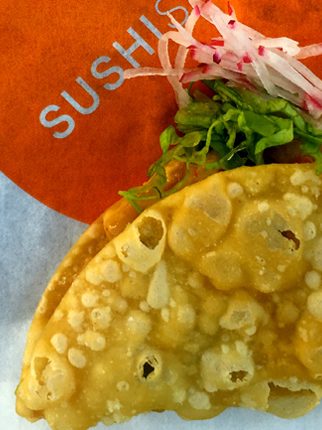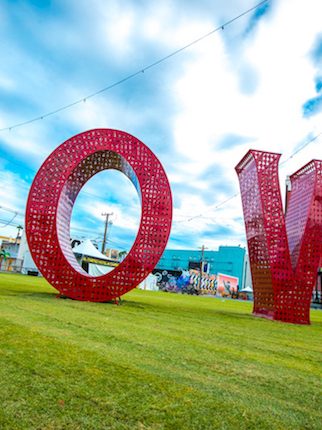Life Is Beautiful and the Creation of Downtown Las Vegas’ Permanent Art Gallery

Different parts of Life Is Beautiful—the music, the food and cocktails, the friends, the wisdom—stay with everyone who attends the festival. But one element actually stays with the city: the outdoor art. Since 2013, Life Is Beautiful has undertaken an ongoing outdoor art project that has shaped and influenced the spirit of Downtown Las Vegas, and the “unveiling” of the new works each year has become one of the most anticipated elements of the event.
The person at the forefront of this effort is Charlotte Dutoit of JUSTKIDS. This endlessly traveling Parisian coordinates projects for festivals and sites all over the world, but she admits the Downtown Las Vegas landscape is definitely something unique. While balancing her time between the installations here and another very different festival in Arkansas earlier this month, Charlotte took some time to help us understand how it all comes together.

Tell me how JUSTKIDS functions: Is it an artistic collective, or is it a sort of curation entity, like a gallery?
JUSTKIDS is a creative house of artists, curators, events creators and brand marketers. Together we produce, curate and manage art projects for institutions, cities, brands and private clientele. It’s allowed me to collaborate and work with people that are really inspiring.
How did you initially get involved with LIB, and what were your thoughts about this project/festival in comparison to your other experiences?
It started four years ago, when the redevelopment of East Fremont and Downtown Las Vegas was just starting. There were not many things happening at that time—besides the Downtown casinos, a couple of bars, and lots of construction—but there was a really good energy and spirit; you could feel that something bigger was happening. The Life Is Beautiful team was planning this very ambitious festival compiling music, arts, food and learning components and wanted to give a real space to visual artists. They invited me to check out the site. I immediately loved the location and history of old-school Las Vegas, so I proposed the mural and installation program, which was adapted for the event and by extension for Downtown, as well.
Can you explain your role?
My job goes from artistic visioning to hands-on delivery. The conception of the lineup, team recruiting and supervision, location selection, equipment and material logistics, the planning, the designing, the marketing, merchandising, et cetera. I’m not alone, of course. Life Is Beautiful is a perfect example of spectacular teamwork, and we learn a lot from each other each year.

What were your initial impressions of Las Vegas and its relationship to public art, and have those impressions changed or been affirmed?
I thought that there were a lot of great spaces and locations available but not so many initiatives around public art. Actually, for my taste, some of the most interesting art projects were inside the private Strip resorts, like the Cosmopolitan parking garage that’s been painted by Retna, Shepard Fairey and Kenny Scharf.
But after that first edition of Life Is beautiful, the mayor awarded us for the best public art design project, which was a great recognition for the participating artists and very rewarding for our efforts. Also, the art in Downtown brought a lot of public dialogue into the community, so it was healthy for everybody, I think.
What are the particular challenges of producing art for a festival environment that is also intended to live on when the city resumes its “normal life,” so to speak—as opposed to a remote festival—and does that influence the consideration of what art gets chosen?
We are programming art for a three-day festival, but on the other hand, we are also building a permanent outdoor gallery for Downtown. And that’s really the most challenging part of it: how to display art that will entertain our attendees, as well as inspire the Downtown community for the rest of the year. Even on a construction level, it changes the way we plan the installations. How are we going to build it so it lasts, despite [things like] the drastic climate changes of Vegas and the strong winds?
But I really enjoy that aspect, because it’s allowed me to plan over a few years for a whole neighborhood, and I can really meet with the people that live or work Downtown and have a better understanding of the neighborhood dynamic and expectations. There are people that live in Las Vegas that would probably never have the chance to see works like these, because they aren’t able to travel or maybe just wouldn’t feel comfortable enough to enter a gallery.
Some of the art from earlier years has been subjected to vandalism, which is unfortunate. Do you think there’s any way to prevent this?
Not so much, actually. We have been lucky—so far, we just had a few tags here and there, but nothing really problematic. We try to clean the mess immediately, because as soon as it starts, it attracts more and more. But we are in a public space, so it’s part of the street, too—whether we like it or not.
In terms of selection, are you more interested in including the work of particular artists, whatever their mission may be, or are selections made more in terms of the proposed works?
Both, really. We are very open to proposals, especially for installations. I am constantly surprised by the ideas I see from visual artists in the public space. But of course, the proposal needs to be a fit for the festival and the city and the team. And I need to be excited by the project to get the best results.

Do you have relatively free rein to present artists as you wish, or do you also present plans to the festival producers? Is there any kind of coordination with the other elements of the festival?
We always submit our proposals to the producers, but since they are real art enthusiasts, they have been really supportive and open-minded, giving us full creative freedom from day one, which is the best way to work. However, we clearly understand the message and feeling they want to spread, and we work around it.
We also have to work alongside the other components of the festival, such as the music—four massive stage constructions, backstage area, VIP area, et cetera—and a bunch of other exterior parameters, so there is a lot of communication between the different teams.

My observation of the art over the last three years is that the messaging began largely optimistic at first and went quite a bit darker last year, but overall has been certainly post-modern, very pop, and largely Western. Is there a strong sense from year to year of changing the aesthetic or broadening it?
We have artists coming from all around the world, and each one brings his or her own
story, style and folklore. It’s very eclectic, and I believe that’s important. I think that the change in the aesthetic year after year is more related to the evolution of the art, and also to the artists’ accessibility to certain new techniques and new mediums.
You’ve said that you want to avoid the Las Vegas clichés (and bravo for that), but are you looking to create or inspire any new storytelling in terms of Las Vegas, in the tradition of neighborhood murals?
I like to think that through the festival and the artwork that remains in Downtown, we are improving the interest in visual art by bringing culture to an unexpected place and value to a city that is usually perceived as very artificial.
Are there any sites in the footprint that have been particular challenges, or where the artwork made an interesting adaptation to the canvas—this year, or in years past?
Pretty much the whole footprint, but we are extending along East Fremont a bit more each year. This year, we have the Ferguson Motel that will be opened with Mike Ross’ Big Rig Jig piece; that’s a must-see!
How much attention do you expect or desire to see festivalgoers pay toward the art? Do you wish they spent half their time looking at it, or are you happy for them to just absorb in passing? Do you think the more interactive artworks encourage people to consider the art as a whole, or is it just for fun?
I think everybody has his own perception and way of appreciating or experiencing the art. Of course, interactive artworks—due to their playful aspects—are more mainstream. However, the people attending Life Is Beautiful are curious about culture in general. It’s important to bring art outside of the conventional ways of experiencing it, which are usually galleries and museums.
Once all the art is installed, how do you personally experience the festival?
I check out the bands, and I spy on people’s reactions! It helps me to improve for future events. What worked, what was the most popular, why. And sometimes, it’s really surprising!






